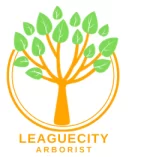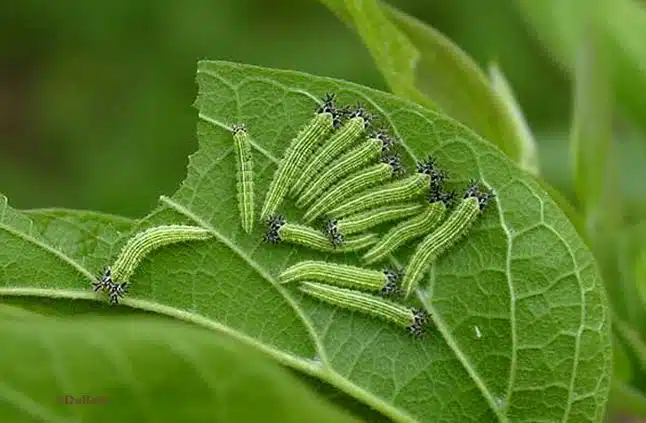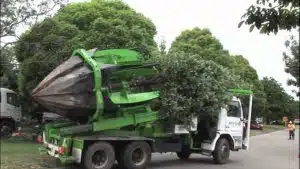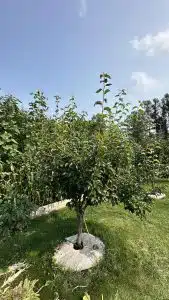Welcome to the magical world of arboriculture in League City, where the exquisite dance of caterpillars hanging from trees reveals nature’s rich tapestry. Our dedication as arborists extends beyond branch pruning and structural soundness; it also includes recognizing and living with the many ecosystems that thrive within our city’s green canopy. In this detailed tour, we will investigate the secrets of caterpillars, the subtle engineers of change in our arboreal habitat. League City arborists perform an important role in maintaining the health and vitality of our trees, and understanding caterpillars is critical to our success. This article seeks to simplify arboriculture by focusing on caterpillar interactions with trees. This guide covers everything from intervention approaches to behaviour patterns.
Caterpillars Hanging from trees
Understanding Caterpillar Behavior:
Discover the intriguing world of caterpillar behaviour, an important component of arboriculture. From eating habits to cocoon production, learn about the subtleties that influence the interplay between these insects and the trees in League City.
Navigating the Arboreal Symphony
In the intricate tapestry of League City’s arboreal realm, caterpillar behaviour emerges as a mesmerizing symphony that influences natural harmony. Arborists, like conductors, must understand the subtleties of the symphony in order to organize their interventions successfully. Caterpillars hanging from trees, in their various varieties, exhibit unique behaviours that provide insight into their life cycles. Understanding their feeding habits, preferred habitats, and cocoon-building inclinations is critical. League City arborists must determine how these behaviours affect the health of the trees they care for. Observing caterpillar behaviour helps to predict probable problems. Recognizing when these voracious eaters may strip foliage or damage trees is critical in applying preemptive measures. This section goes into the complicated dance of caterpillar behaviour, enabling arborists to understand the subtle.
Identifying Tree-Specific Caterpillars: Arboreal Detectives Unveiling Nature’s Secrets
Each tree species in League City’s lush foliage has its own ensemble of caterpillars, nature’s personalized artists. Arborists, like detectives, must learn the talent of detecting tree-specific caterpillars in order to properly customize interventions.
Different trees attract different types of caterpillars, and this section will help League City arborists in their roles as arboreal investigators. From the intricate canopy of the oak to the robust limbs of the maple, comprehending the caterpillar occupants is critical. Identification is more than just a taxonomic exercise; it’s a strategic method to tackling potential threats and preserving the symbiotic link between trees and their insect inhabitants. Arborists will investigate the small differences between caterpillar species, improving their ability to give focused treatment. Join us!
Caterpillar hanging from tree’s impact on Tree Health:
Assess the impact of caterpillars on overall tree health. League City arborists must be vigilant for symptoms of stress and potential damage caused by these insects in order to conduct early and efficient preventive actions that protect the urban greenery.
Evaluating Caterpillar Impact on Tree Health: Nurturing Urban Greenery
League City arborists perform an important role in preserving the city’s trees, and understanding the influence of caterpillars on tree health is critical. These ravenous eaters can be a major hazard, causing stress and severe harm to the arboreal ecosystem. Arborists must analyze a variety of tree health indices that are influenced by caterpillar presence. Key symptoms that require arborist treatment include defoliation, stunted growth, and changed canopy density. Timely evaluation enables the deployment of focused therapies, lowering the risk of long-term damage. This section serves as a complete guide, teaching arborists how to spot and evaluate indicators of caterpillar-induced stress. By assessing the influence on tree health, League City arborists can proactively protect the urban flora, providing a vibrant environment.
Implementing Eco-Friendly Intervention Techniques
In League City’s changing ecosystem, arborists must not only combat caterpillar infestations, but also demonstrate a dedication to environmental responsibility. This section delves into new and environmentally friendly intervention strategies that protect tree health while maintaining nature’s delicate balance. Arborists in League City can use natural predators, biological controls, or pheromone traps to combat pests. Arborists actively contribute to ecological harmony in urban areas by employing these strategies. Arborists, as caretakers of green places, play an important role in establishing sustainable practices. The use of environmentally friendly procedures not only protects tree health but also promotes a healthy ecosystem. This guidance enables League City arborists to implement appropriate intervention tactics that ensure the urban canopy thrives in harmony with the surrounding natural world.
Importance of Timely Arborist Consultation
League City arborists hold the key to sustaining the health and vitality of trees in the delicate dance between nature and urban development. This section emphasizes the crucial significance of contacting an arborist as soon as caterpillars are discovered, emphasizing the mutually beneficial interaction between arborists and the arboreal habitat. Early response is critical in limiting the possible consequences of caterpillar infestations. Arborists act as watchdogs, evaluating symptoms of stress and proposing measures to keep the urban flora balanced. Arborists contribute to the long-term health of trees by instilling in site owners a sense of urgency to seek professional help as soon as possible. League City’s arborists help to preserve the city’s natural beauty through proactive engagement and timely consultations.
Related Posts:
Simplifying Arborist Language: Bridging the Communication Gap
League City arborists are more than just tree guards; they are also communicators, putting the complexity of their field into language that site owners can understand. This section delves into the skill of simplifying arborist jargon when addressing caterpillars hanging from trees. Arborists must explain the subtleties of caterpillar interactions in a way that resonates with site owners. Effective communication is essential for discussing the effects on tree health as well as detailing intervention strategies. This guide provides arborists with the ability to express complicated subjects in simple, relatable language, resulting in a better comprehension among clients. Arborists must explain the complexities of caterpillar relationships in a way that site owners understand. Effective communication is critical for discussing the effects on tree health and outlining intervention possibilities. This tutorial teaches arborists how to express complicated concepts in simple, understandable language, which fosters a greater understanding among clients.
League City arborists enhance their link with site owners by adopting open communication, improving cooperation in urban greenery preservation. This area is a significant resource for arborists, allowing them to bridge the communication gap and ensure that their expertise is accessible and understandable to all stakeholders in the arboriculture journey.
FAQS
Are all caterpillars harmful to trees?
Not every caterpillar is a threat to trees. Understanding the difference between dangerous and benign species is critical for targeted arboricultural interventions.
How do arborists safely remove caterpillar infestations?
League City arborists can safely eliminate caterpillar infestations using environmentally appropriate methods, maintaining tree health while reducing environmental damage.
What Trees Are Most Susceptible to Caterpillar Infestations?
Certain tree species are more prone to caterpillar infestation. Identifying susceptible trees enables arborists to take proactive preventive steps.
Can caterpillar infestations spread to other trees?
Caterpillar infestations can spread to other trees if not treated swiftly. Arborists must evaluate the possibility of infestation spread during interventions.
How Long Does it Take Caterpillars to Cause Significant Damage?
Caterpillars take different amounts of time to produce substantial harm depending on the species, tree health, and environmental circumstances. Arborists must examine these characteristics in order to make accurate projections.
Conclusion
Arborists guard nature’s symphony in League City’s vibrant landscape, where caterpillars dance amid trees. This detailed book delves into the complex world of caterpillars hanging from trees, providing League City arborists with knowledge, perspectives, and effective communication tactics.
From studying caterpillar behaviour to applying eco-friendly solutions, this guide illuminates the way to arboricultural excellence. Arborists have an important role not only in assessing the influence of these creatures on tree health, but also in promoting a balanced interaction between urban growth and nature.




